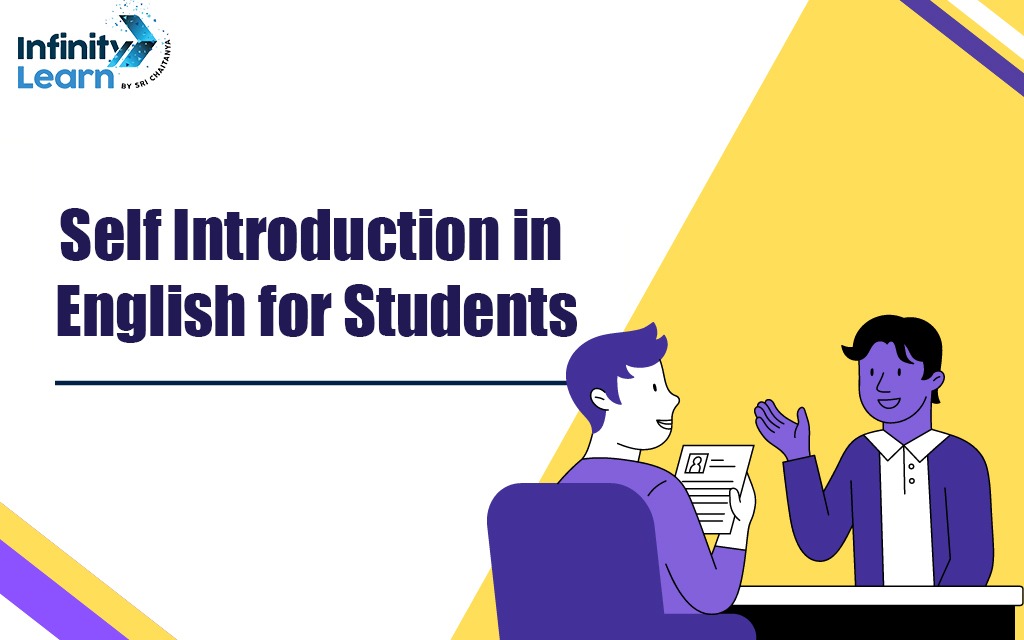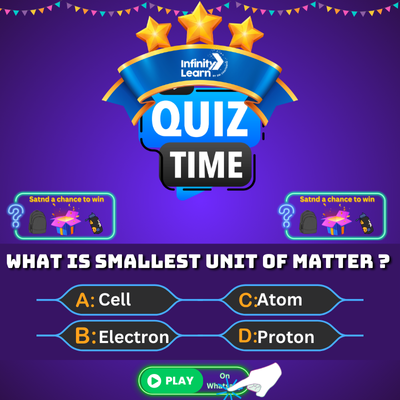Table of Contents
Self Introduction in English for Students: A self-introduction for students is a way to briefly share who they are, creating a connection and making a positive first impression. Whether in school, college, or during interviews, introducing oneself helps others understand important details like their name, background, interests, and goals. This skill is essential for students, as it helps them build confidence and interact effectively in new environments, such as classrooms, social events, or professional settings. A well-prepared self-introduction serves as an icebreaker and sets the tone for meaningful conversations, showcasing their personality and ambitions.

What is Self Introduction?
Self-introduction is the process of presenting yourself to others by sharing key information about your identity, background, interests, and goals. It is a vital communication skill used in various situations like interviews, classrooms, networking events, and social gatherings. A good self-introduction not only helps establish a connection but also leaves a lasting impression by highlighting your personality and aspirations. This essential tool helps individuals confidently engage in conversations and navigate new environments effectively.
Also Check:
Effective Ways to Give a Self-Introduction in English for Students
Introducing yourself as a student in English involves presenting key details in a clear, confident, and engaging manner. Here’s how you can structure your self-introduction:
1. Start with a Greeting
Begin with a polite greeting such as, “Good morning” or “Hello, everyone.” This sets a positive tone for the introduction.
2. Share Your Name and Basic Details
State your name and age (if necessary) and mention where you are from. For example:
“My name is Rahul Sharma, and I am a 16-year-old from Jaipur.”
3. Highlight Your Educational Background
Share what you are currently studying and your school or college name. For instance:
“I am currently in Class 11, studying at ABC High School, focusing on science with a keen interest in biology.”
4. Discuss Your Interests and Hobbies
Talk about your passions, extracurricular activities, or hobbies that make you unique. Example:
“In my free time, I enjoy reading novels, playing chess, and exploring coding projects.”
5. Mention Your Aspirations
Briefly explain your future goals or what you hope to achieve as a student. For example:
“My goal is to pursue a career as a software engineer, where I can play a role in developing groundbreaking technological advancements.”
6. Add a Personal Touch
Include a small detail that makes your introduction memorable, like a fun fact or something unique about yourself.
“A fun fact about me is that I’ve already created two simple apps for my school.”
7. Conclude with Gratitude
End your introduction politely by thanking the audience.
I appreciate the chance to introduce myself. Thank you for this opportunity. I’m excited to learn and grow with all of you.
A confident self-introduction not only leaves a great impression but also helps you build connections and make a strong start in any new setting.
What Is a Self Introduction?
A self introduction is the art of presenting yourself to others in a clear, engaging, and memorable way. Whether you’re a high school student meeting new classmates, a college student at a networking event, or preparing for an interview, knowing how to introduce yourself effectively in English is a fundamental skill that will serve you throughout your academic and professional life.
Self-introduction for students is particularly important as it helps establish your identity in educational settings and creates a foundation for meaningful interactions with peers, teachers, and potential employers. An effective English self-introduction showcases not just who you are, but also your communication skills and confidence.
Basic Structure of Self-Introduction
Creating a strong student introduction requires understanding the essential components. Here’s a comprehensive breakdown of how to introduce yourself properly:
1. Greeting Phrases for Self-Introduction
Begin with an appropriate greeting based on the context:
- Formal self-introduction: “Good morning/afternoon/evening, everyone.”
- Casual self-introduction: “Hi everyone, how’s it going?”
- Neutral self-introduction tone: “Hello, it’s nice to meet you all.”
- Professional self-introduction: “It’s a pleasure to meet you.”
2. Name Introduction
Clearly state your name using one of these approaches:
- Simple: “My name is [Your Name].”
- Full Name: “My full name is [Your Full Name].”
- Nickname: “You can call me [Your Nickname].”
- Formal: “I am [Your Full Name].”
3. Educational Background
For a student introduction in school or college:
- Current status: “I am a [Year] student at [School/University Name].”
- Major/Concentration: “I’m studying [Your Field] with a focus on [Specialization].”
- Achievements: “I’ve maintained a [GPA] and have been recognized for [Relevant Achievements].”
4. Personal Details in Self-Introduction
Include relevant personal information:
- Where you’re from: “I come from [City/Country].”
- Background: “I grew up in [Location] where I developed an interest in [Relevant Interest].”
- Languages: “Besides English, I also speak [Other Languages].”
5. Interests and Hobbies
Adding personal interests humanizes your self-introduction:
- General: “In my free time, I enjoy [Hobby 1] and [Hobby 2].”
- Specific: “I’m passionate about [Interest] and have been practicing it for [Time Period].”
- Relevance: “My interest in [Hobby] has helped me develop skills in [Related Skill].”
6. Career Aspirations
Particularly important for self introduction for interviews or networking:
- Short-term goals: “I’m currently focused on [Immediate Goal].”
- Long-term vision: “In the future, I hope to [Career Aspiration].”
- Purpose: “I’m drawn to this field because [Motivation].”
7. Closing
End your self-introduction appropriately:
- Formal: “Thank you for your time.”
- Casual: “Looking forward to getting to know all of you!”
- Interactive: “I’d love to hear about you as well.”
Different Types of Self-Introductions Based on Context
Self Introduction for Students in School
When introducing yourself in school, focus on your grade level, favorite subjects, and extracurricular activities:
“Hello everyone! I’m Alex Chen, and I’m in my sophomore year here at Lincoln High School. I especially enjoy science and art classes. Outside of academics, I’m part of the debate club and volunteer at the local animal shelter on weekends. I’m looking forward to making new friends and contributing to our class discussions this year!”
Self Introduction for College Students
College introductions often emphasize your major, academic interests, and future goals:
“Good morning! My name is Samantha Rodriguez, and I’m a junior majoring in Environmental Science at State University. I’m particularly interested in renewable energy solutions and have been working on a research project about solar power efficiency. I’m also the secretary of the Sustainability Club on campus. After graduation, I hope to work with organizations focused on developing clean energy technologies. I’m excited to collaborate with everyone in this seminar!”
Self Introduction for Interviews
For interview settings, highlight relevant skills and experiences:
“Good afternoon. I’m Taylor Johnson, a final-year Marketing student at Business College with a 3.8 GPA. During my studies, I’ve completed two internships at digital marketing agencies where I developed skills in social media management and content creation. I’ve also led the Marketing Club at my college, organizing several successful campus events. I’m particularly drawn to this position because it aligns with my interest in data-driven marketing strategies, and I believe my analytical skills and creative approach would be valuable to your team.”
Self Introduction for Networking
When networking, focus on making connections:
“Hi there! I’m Jordan Smith, a Computer Science student at Tech University. I’m currently focusing on artificial intelligence and machine learning applications. I’ve been working on a project that uses AI to optimize energy usage in smart homes. I noticed from your badge that you work at InnoTech Solutions—their work in sustainable technology is exactly what I’m interested in! I’d love to hear more about your experience in the industry.”
Sample Self-Introduction for Students (1-Minute Examples)
Short Student Introduction (Casual Setting)
“Hey everyone! I’m Alex, a second-year Psychology student from Central University. I’ve always been fascinated by how people think and behave, which is why I chose this field. When I’m not buried in textbooks, you can find me hiking, playing guitar, or experimenting with cooking (though not always successfully!). I’m hoping to specialize in child psychology and eventually work in school counseling. I’m really looking forward to getting to know all of you better!”
Formal Self-Introduction (Academic Setting)
“Good morning. My name is Priya Patel, and I’m a third-year Economics student at National University. My academic interests lie in developmental economics and sustainable financial systems. I’ve maintained a 3.9 GPA and recently completed a research paper on microfinance initiatives in rural communities. Outside of academics, I serve as the treasurer of the Economics Society and volunteer at a financial literacy program for high school students. My goal is to pursue graduate studies in International Development. Thank you for the opportunity to introduce myself.”
Professional Self-Introduction (Interview Setting)
“Good afternoon. I’m Michael Chen, a final-year Computer Engineering student at Tech Institute with a 3.8 GPA. Throughout my academic career, I’ve focused on developing both technical skills in programming and software development, as well as soft skills in team leadership and project management. I’ve completed an internship at InnoTech Solutions where I contributed to developing a mobile application that is now used by over 10,000 users. I’m particularly interested in this position at your company because it aligns with my passion for creating user-friendly technology solutions. I’m excited about the possibility of bringing my technical knowledge and innovative mindset to your team.”
Effective Self-Introduction Techniques and Best Practices
Tips for Self-Introduction in English
- Start with a clear greeting appropriate to the setting
- Speak clearly and at a moderate pace, especially if English isn’t your first language
- Use proper English grammar but don’t worry about being perfect
- Practice pronunciation of difficult words before your introduction
- Vary your vocabulary to show language proficiency
- Use transitional phrases to connect different parts of your introduction
Best Practices for Student Introductions
- Tailor your introduction to the specific context (classroom, interview, networking event)
- Keep it concise but informative—aim for 30 seconds to 2 minutes depending on the setting
- Highlight relevant achievements without appearing boastful
- Show enthusiasm about your field of study or future goals
- Be authentic rather than trying to impress with exaggerations
- Include a memorable detail that helps people remember you
- Practice beforehand but avoid sounding rehearsed
How to Confidently Introduce Yourself in English as a Beginner
- Prepare a simple script with basic information
- Practice with a friend or record yourself
- Focus on clear pronunciation of your name and key details
- Use simple sentence structures that you’re comfortable with
- Learn a few standard greeting phrases by heart
- Don’t rush – it’s better to speak slowly and clearly
- Remember that making mistakes is normal and part of learning
Body Language for Effective Self-Introduction
Your non-verbal cues are just as important as your words when introducing yourself:
- Maintain appropriate eye contact with your audience
- Stand or sit with good posture to project confidence
- Smile naturally to appear approachable
- Use hand gestures moderately to emphasize points
- Avoid nervous habits like fidgeting or playing with hair
- Match your facial expressions to the content of your introduction
- Consider cultural differences in body language when in international settings
Common Mistakes to Avoid During Student Introductions
- Speaking too quickly out of nervousness
- Including too much personal information that isn’t relevant
- Using too many filler words like “um” or “like”
- Speaking in a monotone voice that doesn’t engage listeners
- Focusing only on academic achievements without showing personality
- Memorizing word-for-word which sounds unnatural
- Underselling yourself due to modesty or lack of confidence
- Overusing technical jargon that others might not understand
Tips to Make Your Self-Introduction Memorable as a Student
- Share a brief, relevant anecdote that highlights your character
- Connect your interests to your field of study in an interesting way
- Mention a unique skill or experience that sets you apart
- Ask a thought-provoking question related to your introduction
- Use appropriate humor if it comes naturally to you
- Express genuine enthusiasm for learning or your chosen field
- Conclude with a statement about what you hope to contribute to the class, team, or event
Self-Introduction for Online Classes and Presentations
The digital environment requires some adjustments to your self-introduction approach:
- Test your audio and video before the session begins
- Look directly at the camera to create the impression of eye contact
- Speak slightly more slowly than you would in person
- Consider using a visual aid like a single slide with your key information
- Be mindful of your background and ensure it’s professional or neutral
- Acknowledge the online format in a positive way
- Pay extra attention to your voice modulation to maintain engagement
1 Minute Self Introduction for Students
“Good morning/afternoon everyone,
My name is [Your Name], and I am a [Your Age]-year-old student currently studying in [Your Class/Grade] at [Your School/College Name]. I come from [Your City/Town], and I am passionate about learning and growing as an individual.
Academically, I am particularly interested in [Mention Subject/Field of Interest, e.g., science, literature, or technology], and I actively participate in activities related to [Related Interests or Projects, e.g., coding, writing, or experiments]. Outside the classroom, I enjoy [Your Hobbies, e.g., playing football, painting, or reading novels], which helps me stay creative and balanced.
My future aspiration is to [Mention Your Ambition, e.g., become a doctor, engineer, or author] and make a positive impact on society. I believe in hard work, staying curious, and learning from every experience.
I’m grateful for the opportunity to introduce myself. I look forward to connecting and collaborating with all of you!”
This self-introduction is concise, engaging, and tailored to leave a positive impression.
Self Introduction in English for Students Sample
“Hello everyone,
My name is [Your Name], and I am a [Your Age]-year-old student currently studying in [Your Grade/Class] at [Your School/College Name]. I am from [Your City/Town], and I have a keen interest in learning and exploring new things.
In academics, my favorite subjects are [Mention Subjects, e.g., mathematics, biology, or history], as they challenge me to think critically and creatively. Apart from my studies, I enjoy [Your Hobbies, e.g., reading books, playing cricket, or painting], which help me relax and express myself.
I actively participate in school activities, such as [Mention Activities, e.g., debates, sports, or science fairs], as they give me a platform to grow and build my confidence. My goal is to [Mention Your Ambition, e.g., become an engineer, teacher, or artist] and make a meaningful contribution to society.
I believe in staying positive, working hard, and always being curious to learn something new. I truly appreciate the chance to introduce myself and share a bit about who I am.”
This sample is polite, professional, and suitable for students in various settings.
Self-Introduction in English for Students in an Interview
“Good Morning,
My name is Riya Sharma, and I am a 17-year-old student currently pursuing Class 12 in the Science stream from Delhi Public School, Noida. I am passionate about technology and problem-solving, which drives me to excel in my academics and extracurricular activities.
Throughout my academic journey, I have focused on building a strong foundation in mathematics, physics, and computer science, as I aspire to pursue a career in software engineering. I have participated in various competitions like coding hackathons and science exhibitions, where I secured first place in the inter-school coding challenge last year.
In addition to my academic interests, I enjoy reading books on technology and playing chess, which helps me enhance my strategic thinking. I believe my dedication, curiosity, and commitment to excellence will help me achieve my goals and contribute meaningfully to any opportunity I receive.
I’m grateful for the opportunity to introduce myself and share my story with you.”
Self-Introduction in English for Students in College
“Hello Everyone,
My name is Riya Sharma, and I am excited to be here as a first-year student of B.A. English Literature at St. Xavier’s College, Mumbai.
I completed my schooling at Delhi Public School, Noida, where I discovered my passion for literature and creative writing.
Storytelling has always fascinated me, and during my school years, I actively participated in essay writing and debate competitions, winning several awards. I also took on the role of editor for the school magazine, which helped me improve my writing skills and learn the importance of teamwork and collaboration.
Apart from academics, I enjoy exploring new genres of books, participating in drama clubs, and volunteering for social causes. These activities help me stay balanced and nurture my creativity.
I look forward to learning, growing, and contributing positively to our college community. I truly appreciate the chance to present myself and connect with you.”
Important Tips to Prepare for Self-Introduction in English for Students
- Start with a Smile: Begin your introduction with a confident smile to create a positive impression.
- Structure Your Introduction: Follow a logical flow – start with your name, background, interests, and goals.
- Practice Regularly: Rehearse your introduction aloud to build confidence and reduce nervousness.
- Be Concise and Clear: Keep your introduction brief and avoid unnecessary details.
- Include Relevant Achievements: Highlight accomplishments that align with the situation, such as academic or extracurricular successes.
- Use Simple Language: Avoid complex words; use clear, easy-to-understand sentences.
- Show Enthusiasm: Speak with energy and passion to leave a lasting impression.
- Adapt to the Setting: Tailor your introduction based on whether it’s for an interview, a class, or a networking event.
- Maintain Good Body Language: Stand straight, maintain eye contact, and use subtle hand gestures for emphasis.
- End with a Thank You: Conclude politely, thanking the listener for their time and attention.
Things to Avoid During Self-Introduction for Students
- Overloading with Details: Avoid cramming too much information; focus on the most important aspects.
- Using Slang or Informal Language: Maintain a professional tone, especially in formal settings.
- Speaking Too Fast or Too Slow: Practice maintaining a steady pace to ensure clarity.
- Lack of Confidence: Avoid mumbling or appearing unsure; speak with confidence.
- Rambling Off-Topic: Stick to the structure and avoid unnecessary tangents.
- Forgetting the Audience: Consider who you’re speaking to and customize your introduction accordingly.
- Negative Remarks: Never criticize past experiences or speak negatively about yourself or others.
- Ignoring Non-Verbal Cues: Poor posture, avoiding eye contact, or fidgeting can leave a bad impression.
- Memorizing Word-for-Word: Avoid sounding robotic; aim for a natural and conversational tone.
- Being Too Casual or Overly Formal: Strike a balance depending on the context of the introduction.
Self Introduction for Students in English FAQs
How can a student prepare for a self-introduction in English?
Students can prepare by practicing regularly, structuring their introduction logically, and including relevant details like their name, background, interests, and achievements.
How long should a student’s self-introduction be?
A self-introduction for students should ideally last between 1-2 minutes, keeping it concise and to the point.
How can a student make their self-introduction impressive?
By speaking confidently, maintaining good body language, and showcasing unique skills or achievements relevant to the context.
What tone should students use during self-introduction?
Students should use a polite and enthusiastic tone that matches the formality of the setting.
Can a student mention weaknesses in their self-introduction?
It's better to focus on strengths, but if mentioning weaknesses, frame them as areas of improvement with examples of progress.
Is it necessary to include future goals in a student’s self-introduction?
Including future goals can demonstrate ambition and give the listener insight into the student’s aspirations.
What role does body language play in self-introduction?
Positive body language, such as standing straight and using appropriate gestures, enhances the impression and supports spoken words.








